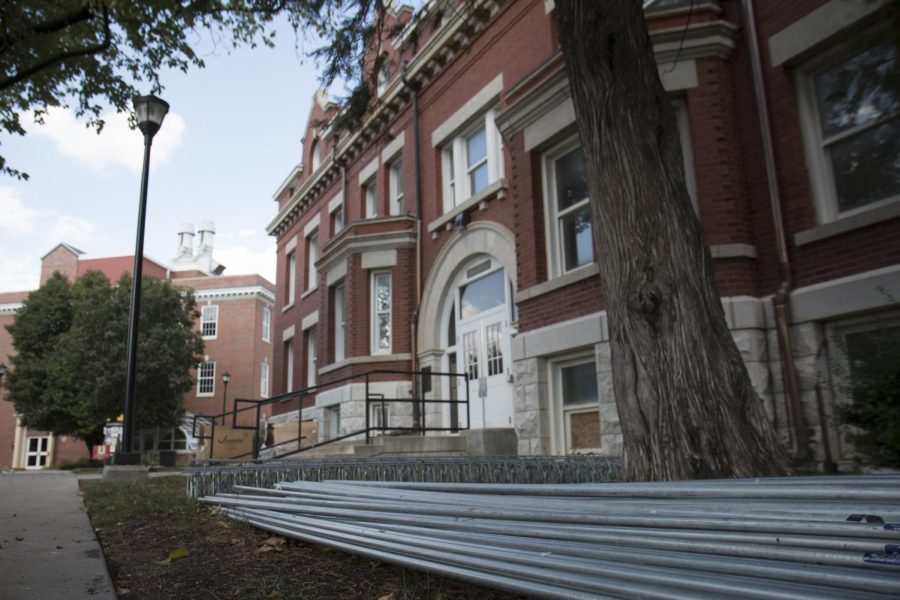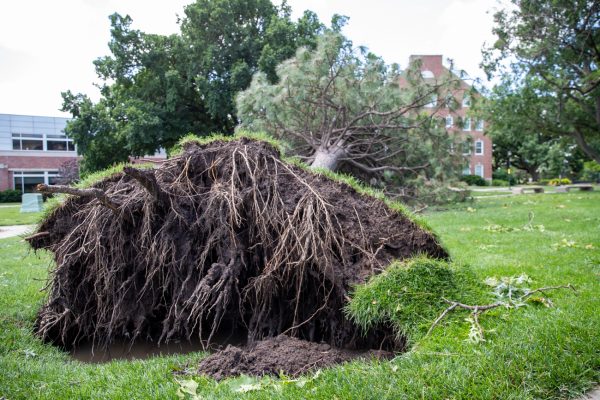Oldest building at WSU to re-open with fewer termites, more accessibility
Building materials lay on the ground near Fiske Hall. Fiske Hall has been under construction since the summer of 2016.
More than two years of construction later, termites, mold, and accessibility issues for students and faculty with disabilities are almost a thing of the past for the oldest building on Wichita State’s campus.
Built in 1904, Fiske Hall is home to the history and philosophy departments. In the summer of 2016, both departments were temporarily relocated so construction could begin.
Renovations to Fiske Hall are expected to be completed in December, and the building ready for use by the spring 2019 semester.
The major renovations include termite and water damage repairs, a new air conditioning system, and a new elevator in compliance with the Americans with Disabilities Act.
The accessibility issue came up with a former history professor who used a wheelchair. With no elevator, the now-retired professor had no way of reaching her office on the first floor.
“She didn’t go in the building for 10 years,” said Susan Castro, a philosophy professor.
“If you go in Fiske in the main entrance, you either have to go downstairs to the basement or upstairs to the first floor,” said James Schwartz, a philosophy professor.
“So there’s no direct entry (to the first floor), and her office is on the first floor, and she had no way to get up to it in a wheelchair,” Schwartz said.
Schwartz said the renovations would make it much easier for students and faculty with disabilities to get around Fiske Hall.
“It was that sort of thing where if you’ve got a student in a wheelchair, they can’t come to your office at all,” Schwartz said.
Schwartz said he was “cautiously optimistic” about the renovations.
Castro said that accessibility for people with disabilities will remain an issue if the power goes out.
“Then we still have that split-level problem,” Castro said. “There is no floor that’s accessible without power.”
Other renovations addressed the building’s aging conditions.
“The floors were a little soft and squishy,” Castro said. “There were places where you could see the termites and the mold in the windowsill. But my office was nice. So it wasn’t the entire building.”
Schwartz said books in the philosophy department were riddled with holes from termites eating through the pages.
“We had termites, we had asbestos, we had mold,” Castro said. “But now we have an elevator.”
Since construction started on Fiske Hall more than two years ago, the philosophy department has been relocated to the basement of Hubbard Hall. The history department was moved to Brennan Hall II, just south of the main campus across 17th Street.
“We’re all very excited to be back in there,” Castro said.
But Castro said the renovations presented a new issue that remains unresolved. The building now has metal framing instead of its old wooden structure.
“Instead of using wooden framing, they used metal framing,” Castro said. “Which means we can’t attach rails for bookshelves like we could before.
“History and philosophy, that’s all we do is books,” she said. “When we move back in, we won’t have enough space for our books.
“That was one of those decisions that I’m sure got made for architectural reasons” without consideration for how the space was going to be used, Castro said.
“It’s unresolved at this point. We’ll see. I’m starting online shopping for bookshelves.”
In its 114-year history, Fiske Hall has served a wide array of functions. During World War I, the Student Army Training Corps housed cadets in the building. During World War II, Fiske Hall was home to military training and in 1945, the ROTC.
Fiske Hall has at some point been home to the music department, geography, international studies, and The Sunflower’s newsroom.
Dating back to the days of Fairmount College, Fiske was originally built as a dorm for male students.
In 1918, when hospitals were full to the brim with victims of the Influenza Epidemic, Fiske Hall served as an infirmary for the flu-stricken.
So when it became clear that the aging building needed attention, preserving the look of the historical building was a priority.
“That was part of the idea,” Castro said. “It’s a historical building and they want it to look the same from the outside and preserve the integrity as much as they can.”

Jenna Farhat was the news editor of The Sunflower. Farhat majored in creative writing.









